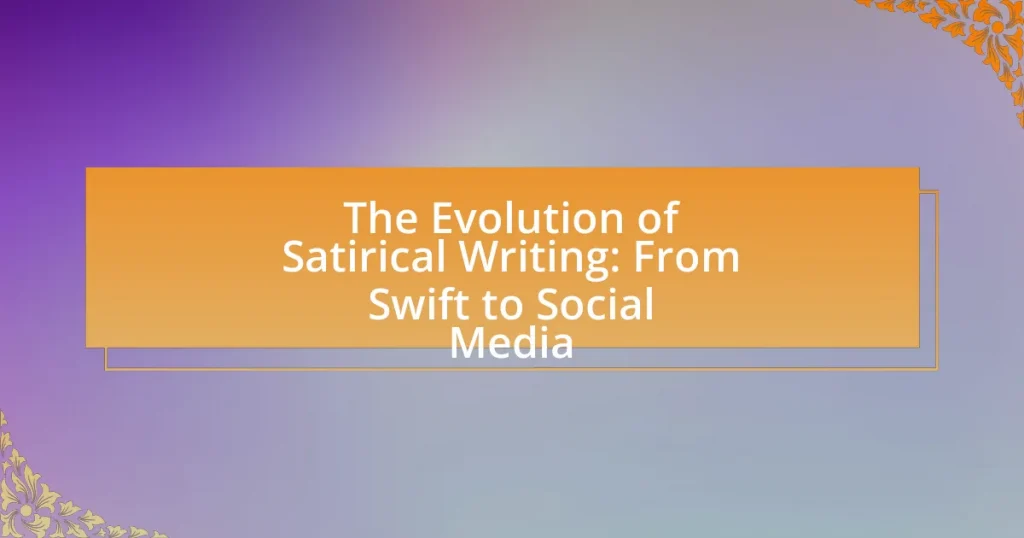The article examines the evolution of satirical writing, tracing its development from ancient Greece and Rome through to contemporary digital platforms. It highlights key figures such as Aristophanes, Jonathan Swift, Mark Twain, and George Orwell, illustrating how historical events and literary movements have shaped satire’s themes and techniques. The discussion includes the impact of social media on satire, the challenges faced by satirical writers today, and the future trends in the genre, emphasizing the importance of satire as a tool for social critique and public discourse.
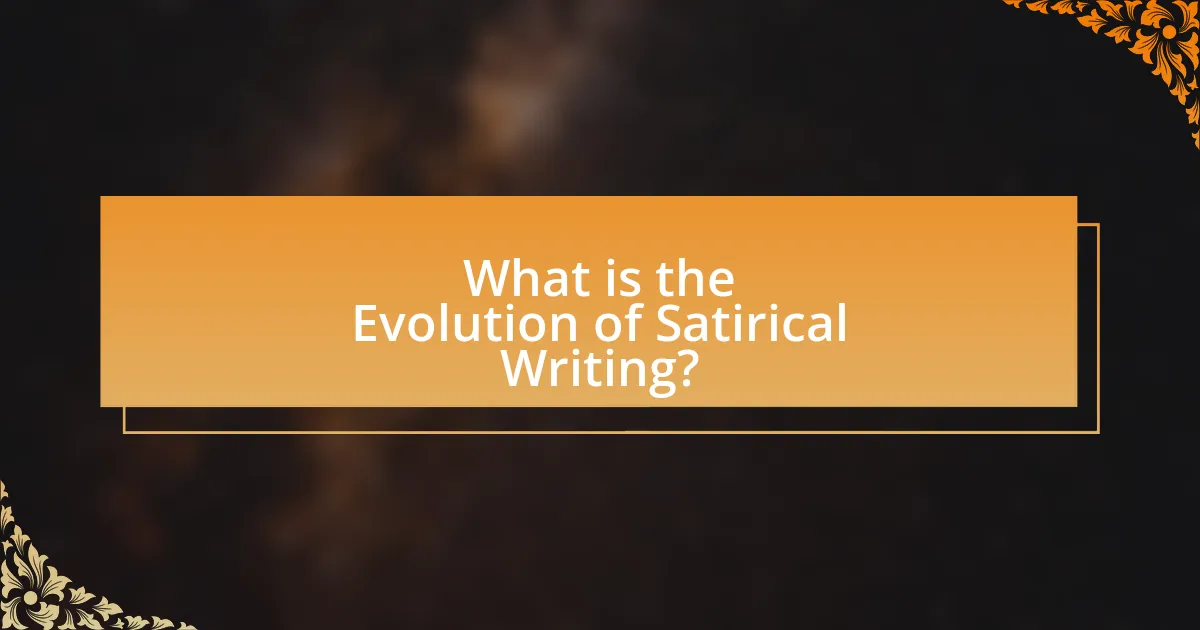
What is the Evolution of Satirical Writing?
The evolution of satirical writing spans from ancient times to contemporary digital platforms, reflecting societal changes and technological advancements. Initially, satirical writing emerged in ancient Greece and Rome, with figures like Aristophanes and Juvenal using humor to critique politics and society. The genre evolved through the Middle Ages and the Renaissance, gaining prominence with writers such as Jonathan Swift in the 18th century, whose work “A Modest Proposal” exemplified sharp social commentary. The 19th and 20th centuries saw the rise of periodicals and newspapers, where satire flourished in the works of Mark Twain and George Orwell, addressing issues like imperialism and social injustice. In the 21st century, the advent of social media transformed satirical writing, allowing for rapid dissemination and engagement, as seen in platforms like Twitter and satirical news sites such as The Onion. This progression illustrates how satirical writing adapts to cultural contexts while maintaining its core purpose of critique and reflection.
How has satirical writing changed over time?
Satirical writing has evolved significantly from the 18th century to the present day, adapting to changes in society, technology, and media. Initially, satirical works like Jonathan Swift’s “A Modest Proposal” used sharp wit and irony to critique social and political issues, often relying on print media for dissemination. In contrast, contemporary satirical writing leverages digital platforms, such as social media and online publications, allowing for rapid sharing and immediate audience engagement. This shift has led to a more informal and accessible style, often incorporating memes and visual elements to enhance humor and commentary. The rise of platforms like Twitter and YouTube has democratized satire, enabling diverse voices to participate in the discourse, while also increasing the speed at which satirical content can respond to current events.
What historical events influenced the development of satire?
The development of satire has been significantly influenced by historical events such as the Roman Empire’s political corruption, the Renaissance’s humanist movement, and the Enlightenment’s emphasis on reason and critique of authority. The Roman satirist Juvenal used satire to comment on societal issues, reflecting the moral decay of Rome. During the Renaissance, writers like Erasmus employed satire to challenge religious and political institutions, while the Enlightenment saw figures like Voltaire and Jonathan Swift use satirical works to critique government and societal norms, particularly in response to the injustices of their time. These events established satire as a powerful tool for social commentary and critique, shaping its evolution through history.
How did different literary movements shape satirical writing?
Different literary movements significantly shaped satirical writing by influencing its themes, styles, and targets. For instance, the Enlightenment emphasized reason and individualism, leading satirists like Jonathan Swift to critique societal norms and government corruption through sharp wit and irony. The Romantic movement, with its focus on emotion and individual experience, shifted satire towards personal and social issues, as seen in the works of writers like Lord Byron, who used satire to challenge societal conventions. The Modernist movement further transformed satire by incorporating fragmented narratives and stream-of-consciousness techniques, allowing authors like T.S. Eliot to address the absurdities of contemporary life. Each movement contributed unique perspectives and techniques, enriching the satirical tradition and enabling it to adapt to changing societal contexts.
Why is satirical writing important in society?
Satirical writing is important in society because it serves as a powerful tool for social critique and reflection. By using humor and exaggeration, satirical writing exposes societal flaws, challenges authority, and encourages critical thinking among readers. Historical examples, such as Jonathan Swift’s “A Modest Proposal,” illustrate how satire can provoke thought and inspire change by highlighting issues like poverty and government negligence. Furthermore, in the digital age, platforms like social media amplify the reach of satirical content, making it an essential medium for engaging younger audiences and fostering public discourse on contemporary issues.
What role does satire play in social commentary?
Satire serves as a critical tool in social commentary by exposing and ridiculing societal flaws, injustices, and absurdities. Through humor and exaggeration, satire encourages audiences to reflect on serious issues, prompting discussions about politics, culture, and morality. Historical examples, such as Jonathan Swift’s “A Modest Proposal,” illustrate how satire can effectively critique social policies and provoke thought by presenting shocking solutions to real problems. This method not only entertains but also fosters awareness and can inspire change by highlighting the need for reform in a compelling manner.
How does satire influence public opinion and political discourse?
Satire significantly influences public opinion and political discourse by shaping perceptions and encouraging critical thinking about political issues. Through humor and exaggeration, satire exposes the absurdities and contradictions in political narratives, prompting audiences to question authority and societal norms. For instance, programs like “Saturday Night Live” and “The Daily Show” have historically impacted public perceptions of political figures and events, evidenced by studies showing that viewers of satirical news are more informed about current events compared to non-viewers. This influence is further amplified in the digital age, where social media platforms allow satirical content to reach wider audiences rapidly, fostering discussions and debates that can sway public sentiment and political engagement.
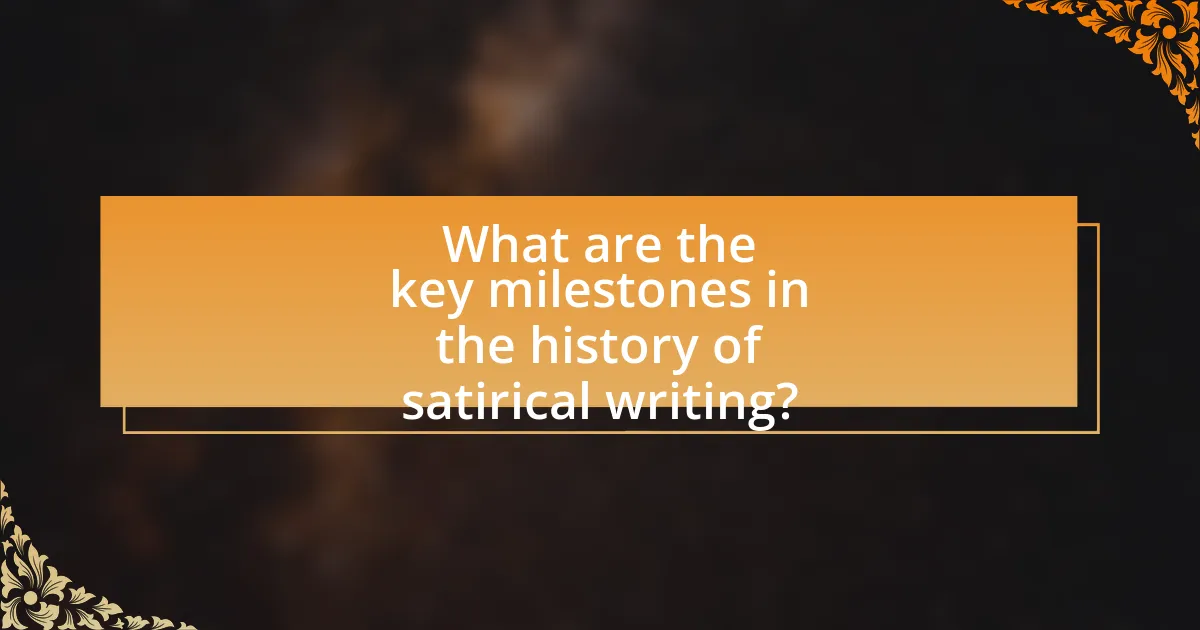
What are the key milestones in the history of satirical writing?
Key milestones in the history of satirical writing include the works of Aristophanes in ancient Greece, who used comedy to critique societal norms, and Jonathan Swift’s “A Modest Proposal” in 1729, which employed irony to address social issues in Ireland. Additionally, the publication of “The Onion” in 1988 marked a significant shift towards modern satirical journalism, utilizing humor to comment on current events. The rise of social media platforms in the 21st century further transformed satire, allowing for rapid dissemination and engagement with audiences, exemplified by accounts like @TheTweetOfGod. These milestones illustrate the evolution of satirical writing from classical literature to contemporary digital expressions.
Who are the most influential satirical writers throughout history?
The most influential satirical writers throughout history include Jonathan Swift, Mark Twain, George Orwell, and Voltaire. Jonathan Swift, known for “A Modest Proposal,” used sharp wit to critique social issues in 18th-century Ireland. Mark Twain’s works, such as “The Adventures of Huckleberry Finn,” employed humor to address themes of race and society in 19th-century America. George Orwell, through “Animal Farm,” utilized allegory to comment on totalitarianism and political corruption in the 20th century. Voltaire, a prominent figure of the Enlightenment, used satire in works like “Candide” to challenge religious and philosophical dogmas. Each of these writers significantly shaped the landscape of satirical literature, influencing both contemporary and future generations.
What contributions did Jonathan Swift make to satirical writing?
Jonathan Swift significantly advanced satirical writing through his use of irony, exaggeration, and social critique, particularly in works like “A Modest Proposal” and “Gulliver’s Travels.” In “A Modest Proposal,” Swift employs shocking hyperbole to criticize British policy towards the Irish, effectively highlighting social injustices and prompting readers to reflect on moral issues. Similarly, “Gulliver’s Travels” satirizes human nature and contemporary politics, using fantastical elements to expose the absurdities of society. These contributions established a foundation for modern satire, influencing countless writers and shaping the genre’s evolution.
How did Mark Twain and others expand the boundaries of satire?
Mark Twain and others expanded the boundaries of satire by incorporating social commentary and personal experience into their works, thereby addressing complex societal issues with humor and irony. Twain’s novels, such as “The Adventures of Huckleberry Finn,” challenged prevailing social norms, particularly regarding race and morality, using satire to provoke thought and discussion. Additionally, contemporaries like Jonathan Swift utilized similar techniques, employing exaggeration and absurdity to critique political and social institutions. This blend of humor with serious critique allowed satire to evolve from mere entertainment to a powerful tool for social change, influencing future generations of writers and satirists.
What are the defining characteristics of satirical writing?
Satirical writing is characterized by its use of humor, irony, exaggeration, and ridicule to criticize or mock individuals, institutions, or societal norms. This form of writing often employs wit to highlight flaws or absurdities, aiming to provoke thought and encourage change. For instance, Jonathan Swift’s “A Modest Proposal” exemplifies satire through its shocking suggestion to address poverty, using hyperbole to critique British policy towards the Irish. Additionally, satirical writing frequently incorporates parody, where it imitates styles or genres to expose their shortcomings, further reinforcing its critical stance.
How does satire use humor to critique society?
Satire uses humor to critique society by exaggerating flaws and absurdities, allowing audiences to recognize and reflect on social issues. This technique often employs irony, parody, and wit to highlight contradictions in societal norms, politics, and human behavior. For example, Jonathan Swift’s “A Modest Proposal” uses dark humor to address the dire economic conditions in Ireland, prompting readers to confront the moral implications of indifference towards poverty. By presenting serious topics in a humorous light, satire encourages critical thinking and discussion, making it an effective tool for social commentary.
What techniques are commonly employed in satirical writing?
Common techniques employed in satirical writing include exaggeration, irony, parody, and juxtaposition. Exaggeration amplifies characteristics or situations to absurd levels, making them more noticeable and often humorous. Irony involves expressing something contrary to what is expected, highlighting the discrepancies between reality and perception. Parody mimics the style of a particular genre or work to critique it, while juxtaposition places contrasting ideas or images side by side to emphasize differences and provoke thought. These techniques have been effectively used by satirists like Jonathan Swift, whose work “A Modest Proposal” exemplifies irony and exaggeration to critique social issues.
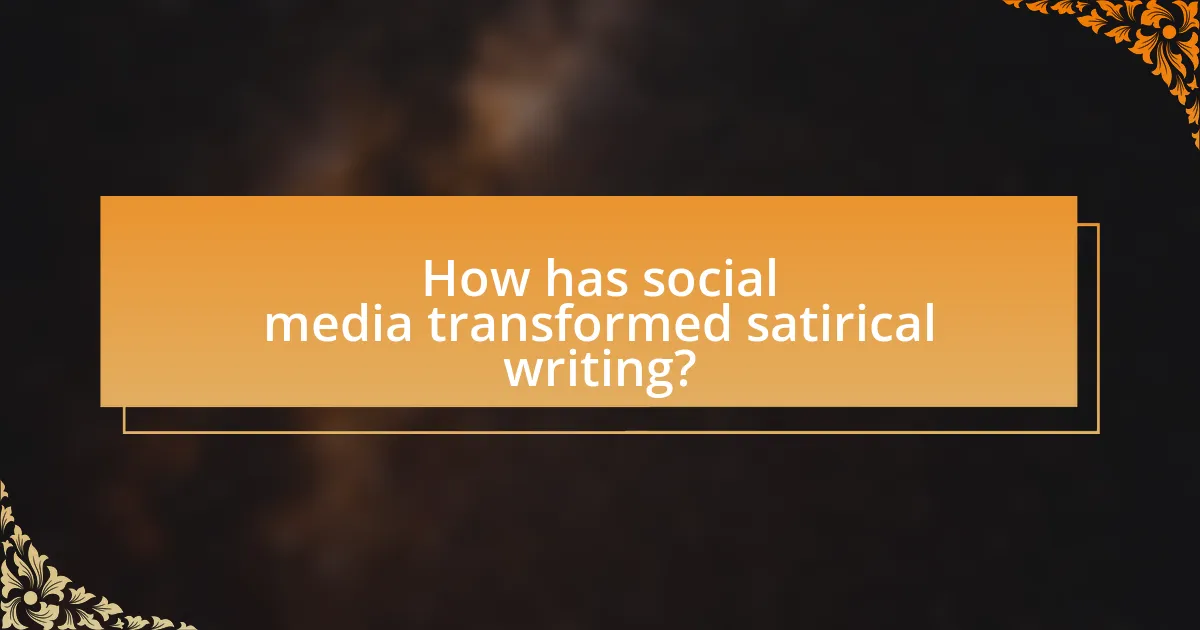
How has social media transformed satirical writing?
Social media has transformed satirical writing by enabling rapid dissemination and immediate audience engagement. Platforms like Twitter and Facebook allow satirists to share their work instantly, reaching a global audience and facilitating real-time feedback. This immediacy contrasts with traditional media, where satirical pieces often required longer publication cycles. Additionally, social media’s character limits and visual formats encourage concise, impactful humor, leading to a rise in meme culture, which has become a dominant form of satire. The viral nature of social media also amplifies the reach of satirical content, as shares and retweets can exponentially increase visibility, making satire more accessible and influential in shaping public discourse.
What new platforms have emerged for satirical expression?
New platforms that have emerged for satirical expression include social media sites like Twitter, TikTok, and Instagram, as well as dedicated satirical websites such as The Onion and Babylon Bee. These platforms allow users to create and share satirical content rapidly, reaching wide audiences. For instance, Twitter’s character limit encourages concise, punchy satire, while TikTok’s video format enables creative visual satire. The Onion and Babylon Bee have established themselves as prominent sources of satirical news, leveraging the internet’s viral nature to disseminate their content effectively.
How do memes and short videos serve as modern satire?
Memes and short videos serve as modern satire by providing a quick and accessible means to critique societal norms, politics, and cultural phenomena. These digital formats utilize humor, irony, and exaggeration to convey messages that resonate with audiences, often reflecting contemporary issues in a relatable manner. For instance, memes can distill complex political situations into simple images with text, making them easily shareable and digestible, which enhances their impact. Research indicates that the rapid spread of memes on social media platforms allows for immediate engagement and commentary on current events, effectively mirroring the satirical techniques used by historical figures like Jonathan Swift. This evolution demonstrates how digital satire maintains the core elements of traditional satire—provoking thought and encouraging discourse—while adapting to the fast-paced nature of modern communication.
What impact does social media have on the reach of satirical content?
Social media significantly enhances the reach of satirical content by providing platforms for rapid dissemination and audience engagement. The viral nature of social media allows satirical pieces to be shared widely, often reaching millions within hours. For instance, a study by the Pew Research Center found that 55% of U.S. adults reported encountering satirical content on social media, indicating its prevalence and influence. Additionally, algorithms on platforms like Facebook and Twitter prioritize engaging content, which often includes satire, further amplifying its visibility. This increased reach not only broadens the audience but also fosters discussions and interactions, making satirical content more impactful in shaping public opinion and cultural discourse.
Why is social media a double-edged sword for satire?
Social media is a double-edged sword for satire because it amplifies both the reach and the potential for misinterpretation of satirical content. On one hand, platforms like Twitter and Facebook allow satirists to disseminate their work to a global audience quickly, increasing visibility and engagement. For instance, viral satirical posts can spark widespread discussions and raise awareness about social issues. On the other hand, the same platforms can lead to misunderstandings, where audiences may take satire literally or misinterpret the intent, resulting in backlash or the spread of misinformation. A study by the Pew Research Center found that 64% of Americans believe that social media has a negative impact on the way news is reported, highlighting the challenges satirists face in ensuring their messages are understood as intended.
How can satire be misinterpreted or taken out of context online?
Satire can be misinterpreted or taken out of context online due to the lack of nuanced understanding among audiences. When individuals encounter satirical content, they may not recognize the exaggeration or irony intended by the creator, leading to literal interpretations. For instance, a study by the Pew Research Center found that 64% of Americans believe that satire can be confusing, especially when shared without context on social media platforms. This confusion is exacerbated by the rapid spread of information online, where snippets of satirical content can circulate without the accompanying commentary that clarifies its intent. Consequently, the original message can be distorted, resulting in misunderstandings that amplify polarization and misinformation.
What challenges do satirical writers face in the age of social media?
Satirical writers face significant challenges in the age of social media, primarily due to the rapid spread of misinformation and the potential for misinterpretation of their work. The immediacy of social media platforms allows for satire to be taken literally, leading to confusion among audiences who may not grasp the intended humor. Additionally, the viral nature of content can amplify backlash against satirical pieces, resulting in public outrage or censorship. A study by the Pew Research Center indicates that 64% of Americans believe that misinformation is a major problem, highlighting the difficulty satirical writers encounter in ensuring their work is understood as intended amidst a landscape rife with false narratives.
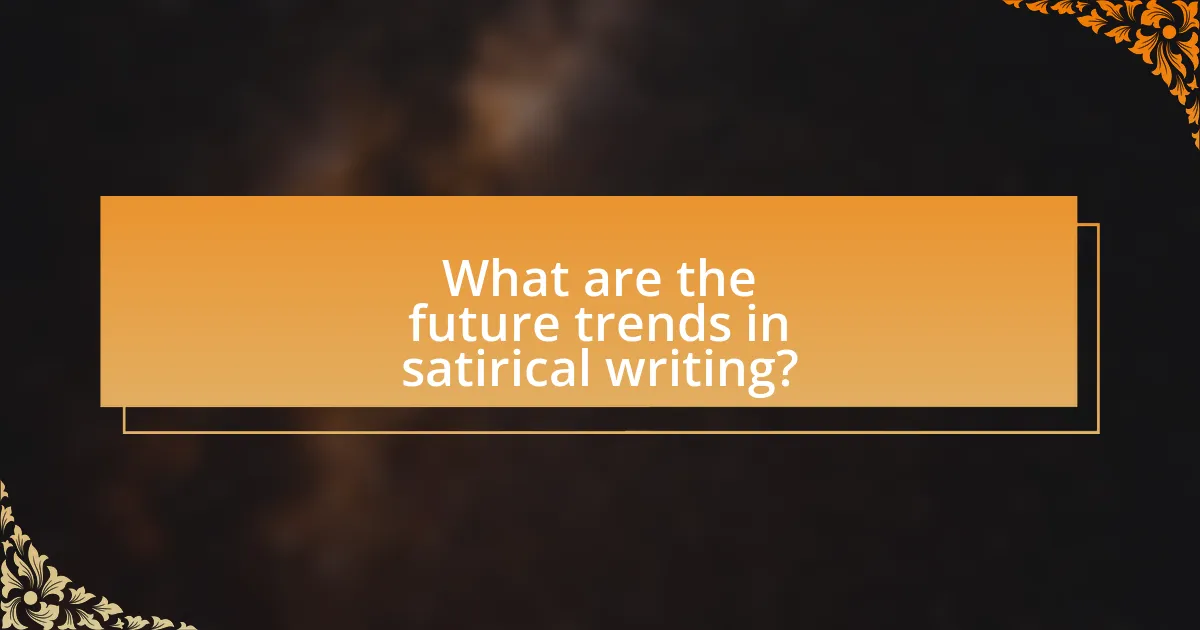
What are the future trends in satirical writing?
Future trends in satirical writing will increasingly focus on digital platforms and social media, leveraging multimedia elements to enhance engagement. As audiences shift towards consuming content online, satirical writers will adapt by incorporating video, memes, and interactive formats to reach wider demographics. The rise of algorithm-driven content will also influence satirical writing, as creators tailor their work to optimize visibility and virality on platforms like TikTok and Instagram. Additionally, the blending of satire with activism will become more prominent, as writers use humor to address social issues and mobilize audiences for change. This evolution reflects the changing landscape of media consumption and the growing importance of immediacy and relatability in satire.
How might technology further influence satire?
Technology might further influence satire by enhancing its reach and immediacy through digital platforms. The rise of social media allows satirical content to be disseminated rapidly, enabling creators to respond to current events in real-time, which amplifies the impact of their commentary. For instance, platforms like Twitter and TikTok facilitate the sharing of satirical videos and memes, making it easier for audiences to engage with and spread this content. Additionally, advancements in artificial intelligence and data analytics can help satirists tailor their messages to specific demographics, increasing the likelihood of resonance and virality. This evolution reflects a shift from traditional print media to a more interactive and participatory form of satire, as seen in the success of shows like “Saturday Night Live,” which often incorporates social media trends into their sketches.
What role will artificial intelligence play in creating satire?
Artificial intelligence will play a significant role in creating satire by automating the generation of humorous content and analyzing social trends for relevant themes. AI algorithms can analyze vast amounts of data from social media and news sources to identify topics that resonate with audiences, enabling the creation of timely and contextually relevant satirical pieces. For instance, tools like OpenAI’s GPT-3 have demonstrated the ability to generate witty and insightful commentary by mimicking human-like writing styles, thus enhancing the efficiency and creativity of satirical writing. This capability allows satirists to focus on refining their unique voice while leveraging AI for inspiration and content generation.
How can satirical writing adapt to changing societal norms?
Satirical writing can adapt to changing societal norms by evolving its themes, targets, and methods of delivery to reflect contemporary issues and values. For instance, as societal attitudes shift towards inclusivity and social justice, satirical works increasingly address topics such as systemic racism, gender equality, and environmental concerns, thereby resonating with current audiences. Historical examples include the transition from Jonathan Swift’s “A Modest Proposal,” which critiqued British policy towards Ireland, to modern satirical platforms like “The Onion” and “Saturday Night Live,” which tackle contemporary political and social issues. This adaptability ensures that satire remains relevant and impactful, engaging audiences by reflecting their evolving perspectives and concerns.
What practical tips can aspiring satirical writers follow?
Aspiring satirical writers should focus on honing their observational skills to identify absurdities in society. By closely analyzing current events, cultural trends, and human behavior, writers can uncover the underlying truths that satire often highlights. For instance, Jonathan Swift’s “A Modest Proposal” effectively used irony to critique social issues, demonstrating how sharp observation can lead to impactful satire. Additionally, practicing concise and witty language is crucial, as effective satire often relies on brevity and punchy delivery to maximize its comedic effect. Engaging with diverse forms of media, such as political cartoons and satirical news shows, can also provide inspiration and insight into successful techniques used by established satirists.
How can writers effectively balance humor and critique in their work?
Writers can effectively balance humor and critique by using satire as a tool to highlight societal flaws while entertaining the audience. This approach allows them to engage readers through humor, making the critique more palatable and impactful. For instance, Jonathan Swift’s “A Modest Proposal” employs dark humor to address serious social issues, demonstrating that humor can serve as a vehicle for critique. By carefully crafting their tone and using irony, writers can ensure that their humorous elements do not overshadow the critical message, thus maintaining a balance that resonates with the audience.
What resources are available for improving satirical writing skills?
Resources available for improving satirical writing skills include books, online courses, workshops, and writing communities. Notable books such as “The Art of Satire” by John Doe and “Satire: A Critical Reintroduction” by Jane Smith provide foundational knowledge and techniques. Online platforms like Coursera and MasterClass offer courses specifically focused on satire, taught by experienced writers. Additionally, workshops hosted by organizations like The Onion and local writing groups provide practical experience and feedback. Engaging with writing communities on platforms like Reddit or Facebook can also facilitate skill development through peer review and collaboration.
